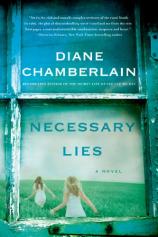Necessary Lies
Review
Necessary Lies
In 1907, the eugenics program --- a movement dedicated to weeding out unfit members of society through the sterilization of “feebleminded” (those with an IQ lower than 70), poor, psychologically unstable, epileptic, promiscuous, or otherwise “socially or racially inferior” individuals --- took hold of America. Chapters of local eugenics groups with names like the Race Betterment Foundation, the Human Betterment League, and the American Eugenics Society began sprouting up around the country. In 1929, North Carolina --- where Diane Chamberlain’s NECESSARY LIES takes place --- gave social workers and county health officials the power to determine whether an individual was “fit” enough to have children responsibly. Astonishingly, 31 other states soon had similar compulsory sterilization laws in place.
By 1977, when the eugenics program petered out, more than 65,000 people had been involuntarily sterilized across the country. Even now, those who went through the program are reeling from its effects. In 2011, North Carolina became the first state to try to retroactively compensate these survivors. But as of the time this review was written, the $50,000 awards still have not been distributed.
"Chamberlain has a knack for highlighting just how complicated the issues are --- and how maddening getting stuck on both sides of the foster care and welfare systems must truly be, not to mention living in a time when eugenics was considered the optimal solution."
In NECESSARY LIES, Diane Chamberlain attempts to put a human face to the eugenics problem and its aftermath --- and she does so from all sides of the controversy. It’s 1960, and newly married 22-year-old Jane Forrester has a lot to look forward to --- a new marriage to a dashing young pediatrician, a new home to decorate, and a new job as a social worker for the Department of Public Welfare in Raleigh. While her job promises a number of unforeseen challenges --- both pinpointing the needs of her clients in rural Grace County while slowly building their trust and learning how to maintain objectivity and distance in her approach to her casework --- Jane is sure she has the brains and the brawn for the work.
Others, however, are not so convinced. Her old-fashioned husband, Robert, would much prefer that she do her part to “fit in” by joining the Junior League and socializing with his colleagues’ snooty non-working wives or spend her days designing their future babies’ nursery than “waste her time” fighting for the rights of people living off welfare handouts. In his mind, the kids “would be better off if they’d never been conceived.” Her colleagues, who have pushed mountains of sterilization petitions through the system without a second thought or a glitch, are also weary of Jane’s excessive empathy while on the job. But the more Jane gets entrenched in her clients’ lives --- especially that of the Harts who live on the Gardiners’ tobacco farm --- the less she wants to follow the bureaucratic rules, or cares what people think, anyway.
While Jane certainly plays a pivotal role in the book, she’s also a rare combination of squeaky-clean and a smidge too spastic for her own good. The real character to contend with --- and the book’s driving force --- is the feisty Ivy Hart. After her father died in a farm accident and her mother was sent to a psych ward, Ivy’s frail and diabetic grandmother, Nonnie, took over running the household. Now that Ivy is 15, she shoulders most of the responsibility --- or tries to. But when Ivy’s flighty 17-year-old sister, Mary Ella, becomes pregnant with Baby William and there’s another mouth to feed, the welfare handouts that arrive every few weeks with Jane’s visits become crucial to the Harts’ survival. In addition to making sure Nonnie takes her “pee pills” for her diabetes, Ivy is saddled with watching Baby William and keeping track of her wandering sister’s whereabouts, all while making time to sneak out at midnight and get nookie from her undisclosed boyfriend, Henry Allen, the Gardiners’ handsome son.
Ivy’s hand-to-mouth existence isn’t under control (especially after she, too, learns she’s pregnant), nor is anyone else’s on the farm, and mounting secrets simmer underneath the mayhem --- Ivy and Henry Allen’s clandestine relationship for one, the identity of Baby William’s father, and the fact that Mary Ella was sterilized without her knowing (she was told the operation was an appendectomy). To Chamberlain’s credit, she keeps most of the characters --- and the reader --- in the dark about the larger picture and what’s going on. When the truths are finally revealed in an ending piled high with drama (including a suicide, a kidnapping, and a shrouded victory), the result is both a surprise and a relief.
NECESSARY LIES sports a deceptively tranquil (i.e. misleading) cover, when what takes place inside is anything but. Some of the plot quirks, such as Jane’s over-the-top bleeding heart/savior complex or the exposure of Mary Ella’s lover (it’s obvious early on), verge on the over-played. But Chamberlain has a knack for highlighting just how complicated the issues are --- and how maddening getting stuck on both sides of the foster care and welfare systems must truly be, not to mention living in a time when eugenics was considered the optimal solution. Thus, when Ivy skips town after learning she is earmarked for sterilization, it’s all we can do but to root for her well being and to urge her on in her fight for the right to procreate.
Reviewed by Alexis Burling on September 6, 2013
Necessary Lies
- Publication Date: October 7, 2014
- Genres: Fiction, Historical Fiction, Women's Fiction
- Paperback: 384 pages
- Publisher: St. Martin's Griffin
- ISBN-10: 1250054516
- ISBN-13: 9781250054517





